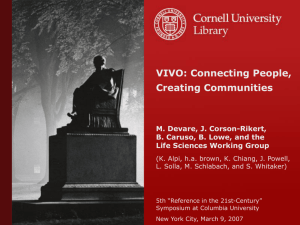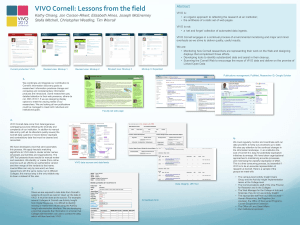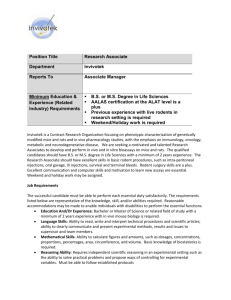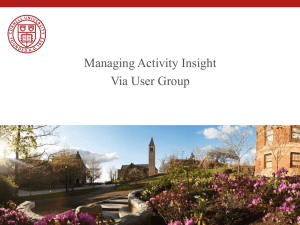VIVO - ALA_MIG
advertisement
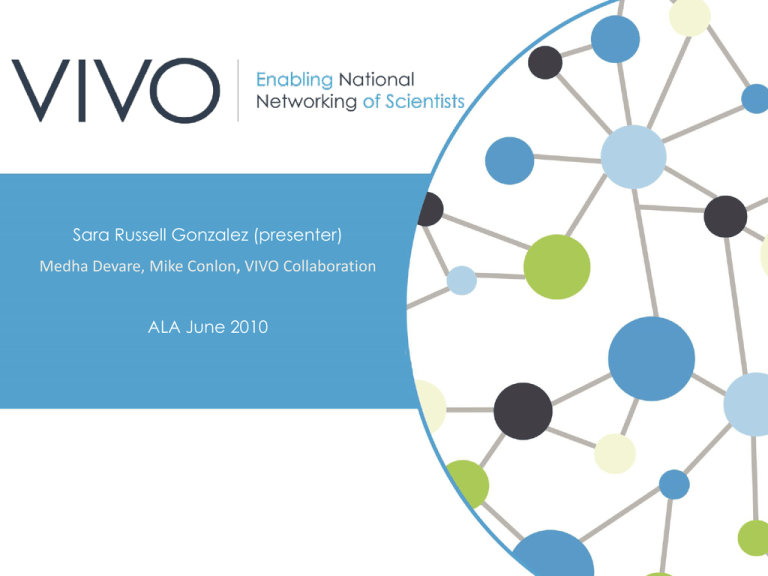
Sara Russell Gonzalez (presenter) Medha Devare, Mike Conlon, VIVO Collaboration ALA June 2010 VIVO Collaboration: Cornell University: Dean Krafft (Cornell PI), Manolo Bevia, Jim Blake, Nick Cappadona, Brian Caruso, Jon Corson-Rikert, Elly Cramer, Medha Devare, Elizabeth Hines, Huda Khan, Brian Lowe, Joseph McEnerney, Holly Mistlebauer, Stella Mitchell, Anup Sawant, Christopher Westling, Rebecca Younes. University of Florida: Mike Conlon (VIVO and UF PI), Chris Barnes, Cecilia Botero, Kerry Britt, Erin Brooks, Amy Buhler, Ellie Bushhousen, Linda Butson, Chris Case, Christine Cogar, Valrie Davis, Mary Edwards, Nita Ferree, George Hack, Chris Haines, Rae Jesano, Margeaux Johnson, Sara Kreinest, Meghan Latorre, Yang Li, Paula Markes, Hannah Norton, Narayan Raum, Alexander Rockwell, Sara Russell Gonzalez, Nancy Schaefer, Dale Scheppler, Nicholas Skaggs, Matthew Tedder, Michele R. Tennant, Alicia Turner, Stephen Williams. Indiana University: Katy Borner (IU PI), Kavitha Chandrasekar, Bin Chen, Shanshan Chen, Jeni Coffey, Suresh Deivasigamani, Ying Ding, Russell Duhon, Jon Dunn, Poornima Gopinath, Julie Hardesty, Brian Keese, Namrata Lele, Micah Linnemeier, Nianli Ma, Robert H. McDonald, Asik Pradhan Gongaju, Mark Price, Yuyin Sun, Chintan Tank, Alan Walsh, Brian Wheeler, Feng Wu, Angela Zoss. Ponce School of Medicine: Richard J. Noel, Jr. (Ponce PI), Ricardo Espada Colon, Damaris Torres Cruz, Michael Vega Negrón. The Scripps Research Institute: Gerald Joyce (Scripps PI), Catherine Dunn, Brant Kelley, Paula King, Angela Murrell, Barbara Noble, Cary Thomas, Michaeleen Trimarchi. Washington University School of Medicine in St. Louis: Rakesh Nagarajan (WUSTL PI), Kristi L. Holmes, Caerie Houchins, George Joseph, Sunita B. Koul, Leslie D. McIntosh. Weill Cornell Medical College: Curtis Cole (Weill PI), Paul Albert, Victor Brodsky, Mark Bronnimann, Adam Cheriff, Oscar Cruz, Dan Dickinson, Richard Hu, Chris Huang, Itay Klaz, Kenneth Lee, Peter Michelini, Grace Migliorisi, John Ruffing, Jason Specland, Tru Tran, Vinay Varughese, Virgil Wong. This project is funded by the National Institutes of Health, U24 RR029822, "VIVO: Enabling National Networking of Scientists". Current Challenges Libraries • Researchers increasingly use online resources—Rarely visit the physical library • How to stay involved with the research process—for collection building and designing new services Researchers • Research is becoming highly interdisciplinary • How can researchers find collaborators, track competitors, and stay abreast of current research inside large institutions, at other institutions, and globally? Administrators • Research institutions can be extremely large • How can administrators showcase and monitor research activity and understand the strengths and weaknesses in an organization. VIVO is: What is VIVO? An open-source semantic web application that enables the discovery of research and scholarship across disciplines in an institution. Populated with detailed profiles of faculty and researchers; displaying items such as publications, teaching, service, and professional affiliations. A powerful search functionality for locating people and information within or across institutions. Who can use VIVO? Faculty/Scholar/Researcher/Scientist • Find collaborators • Track competitors • Keep abreast of new work • Rely on customizable profiles maintained via automatic updates Donor/ Funding Agency Student • Discover current funded projects • Search for specialized expertise • Visualize research activity within an institution • Locate mentors, advisors, or collaborators • Locate events, seminars, courses, programs, facilities • Showcase own research Administrator • Showcase college, program, departmental activities • Identify areas of institutional strength • Manage data in one place …and many more! VIVO origins and current status • Originally developed at Cornell University in 2004 to support Life Sciences • Reimplemented using RDF, OWL, Jena and SPARQL in 2007 • Now covers all faculty, researchers and disciplines at Cornell • Implemented at University of Florida in 2007 In September 2009, seven institutions received $12.2 million in funding from the National Center for Research Resources of the NIH to to enable National Networking with VIVO A Library-based Support Model Libraries: • • • • Are a trusted, neutral entity Have a tradition of service and support Strive to serve all missions of the institution Are technology centers and have IT and data expertise Librarians: • Have skills—information organization, instruction, usability, subject expertise • Have close relationships with their clients (buy in) • Understand user needs • Understand the importance of collaboration and know how to bring people together • Have knowledge of institution, research, education, clinical landscape Searching VIVO VIVO Profiles Repurposing data http://research.cals.cornell.edu https://confluence.cornell.edu/display/collaborate/ http://cals-experts.mannlib.cornell.edu/ http://gradeducation.lifesciences.cornell.edu/ Data, Data, Data VIVO harvests much of its data automatically from verified sources • • Reducing the need for manual input of data. Centralizing information and providing an integrated source of data at an institutional level. Internal data sources External data sources Individuals may also edit and customize their profiles to suit their professional needs. From local to national National browse search share as RDF visualize Exemplar Local nat’l sources > data ingest to RDF > VIVO (RDF) > local sources search browse visualize interactive input > share as RDF • • • • • • • Cornell University University of Florida Indiana University Ponce School of Medicine The Scripps Research Institute Washington University, St. Louis Weill Cornell Medical College Data in VIVO: Semantic Web standards Subject Predicate (verb) Object Riha, Susan research area crop management Riha, Susan international geographic focus Brazil Riha, Susan submitter of impact statement Climate change and its impact on the distribution of invasive weeds Riha, Susan selected publication (authorship) Biomass, harvestable area, and forest structure estimated from commercial timber inventories and remotely sensed imagery in southern Amazonia Stored in Resource Description Framework (RDF) triples Uses the shared VIVO Core Ontology to describe people, organizations, activities, publications, events, interests, grants, and other relationships Incorporates Friend-of-a-Friend (FOAF) and Bibliographic Ontology (BIBO) Supports local ontology extensions for institution-specific needs Storing Data in VIVO has author author of Mining the record: Historical evidence for… author of taught by Susan Riha academic staff in academic staff crop management research area for headed by CSS 4830 faculty appointment in features person research area research area for has author research area teaches featured in Andrew McDonald NYS WRI head of faculty members Earth and Atmospheric Sciences Cornell’s supercomputers crunch weather data to help farmers manage chemicals VIVO enables authoritative data about researchers to join the Linked Data cloud Tim Berners-Lee, http://www.w3.org/2009/Talks/0204-ted-tbl Linked Data principles (Tim Berners-Lee) Use URIs as names for things Use HTTP URIs so that people can look up those names When someone looks up a URI, provide useful information, using standards (RDF, SPARQL) Include links to other URIs so that people can discover more things http://www.w3.org/DesignIssues/LinkedData.html http://linkeddata.org Mike Conlon’s VIVO profile Mike Conlon’s VIVO profile as Linked Data Challenges in the semantic approach Granularity levels Terminologies Scalability Disambiguation Provenance VIVO approach Temporality Make it easy to enter structured data Address trust via authoritative sources Address privacy via focus on public data Jim Hendler, 1997 or 1998, http://www.cs.rpi.edu/~hendler/LittleSemanticsWeb.html What’s ahead? Future versions of VIVO will: Generate CVs and biosketches for faculty reporting or grant proposals. Incorporate external data sources for publications and affiliations. Display visualizations of complex research networks and relationships. Link data to external applications and web pages. Get involved with VIVO (www.vivoweb.org) As an: adopter, data provider, or application developer Thank you! Questions?

